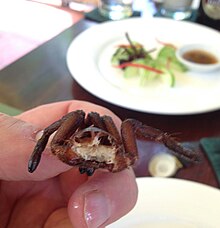Arachnophagy
Arachnophagy(/əˈræknɒfədʒi/, from Greek ἀράχνη aráchnē, 'spider', and φαγεῖν phagein, 'to eat') describes a feeding behaviour that includesarachnids.Aside from non-human creatures, the term can also refer to the practice of eating arachnids among humans.[1]
In non-humans[edit]

Arachnophagy is widespread among many animals, especially reptiles and birds. For example, arachnophagy is described amongPhilippine scops owlsthat feed on spider species such asHeteropoda venatoria.[2]
In humans[edit]



Like the human consumption of insects (anthropo-entomophagy), arachnids as well asmyriapodsalso have a history of traditional consumption, eitheras foodor medicine. Arachnids includespiders,scorpionsandmites(includingticks) that are consumed by humans worldwide.[3]
Fried spider,primarily tarantula species, is a regional snack inCambodia.In Mexico, tarantula have been offered in tacos, with a splash of guacamole.[4]However, Mexican law forbids the sale of many species of tarantula for human consumption, and vendors offering this delicacy have been shut down by authorities.[5]In Venezuela, thePiaroa peoplehave a history of eating theGoliath birdeatertarantula (Theraphosa blondi).[6]
Fried scorpion is traditionally eaten inShandong,China.[7]Other countries include Vietnam and Thailand.[6]
Milbenkäseis a German specialitycheesethat is exposed tocheese mitesduring ripening, and on consumption often still has mites attached to the rind.[8]
References[edit]
- ^Christopher Healey, Margaret Florey (2003):Alune arachnophagy and approaches to spiders among an eastern Indonesian people.In: Journal of ethnobiology. Vol. 23, pp. 1–22.
- ^Barrion-Dupo, A. L. A. (2009). Arachnophagy by the Philippine scops-owl, Otus megalotis Walden.Philippine Entomologist,23(2), 174-178.
- ^E.M. Costa-Neto, N.T. Grabowski (27 November 2020):Edible arachnids and myriapods worldwide – updated list, nutritional profile and food hygiene implications.In: Journal of Insects as Food and Feed: 0 (0), pp. 1-20. doi:https://doi.org/10.3920/JIFF2020.0046
- ^"¡A comer tarántula! (no en Camboya, sino en México)".animalgourmet(in Mexican Spanish). 27 February 2018.Retrieved2018-09-25.
- ^"Aseguran tarántulas que serían convertidas en tacos | Animal Político".animalpolitico(in European Spanish). 15 August 2018.Retrieved2018-09-25.
- ^abNBC News/Beth Greenwald (27 October 2011):15 insects you won't believe are edible.
- ^Forney, Matthew (June 11, 2008)."Scorpions for Breakfast and Snails for Dinner".The New York Times.
- ^"Würchwitzer Milbenkäse".Slow Food Deutschland e.V.
